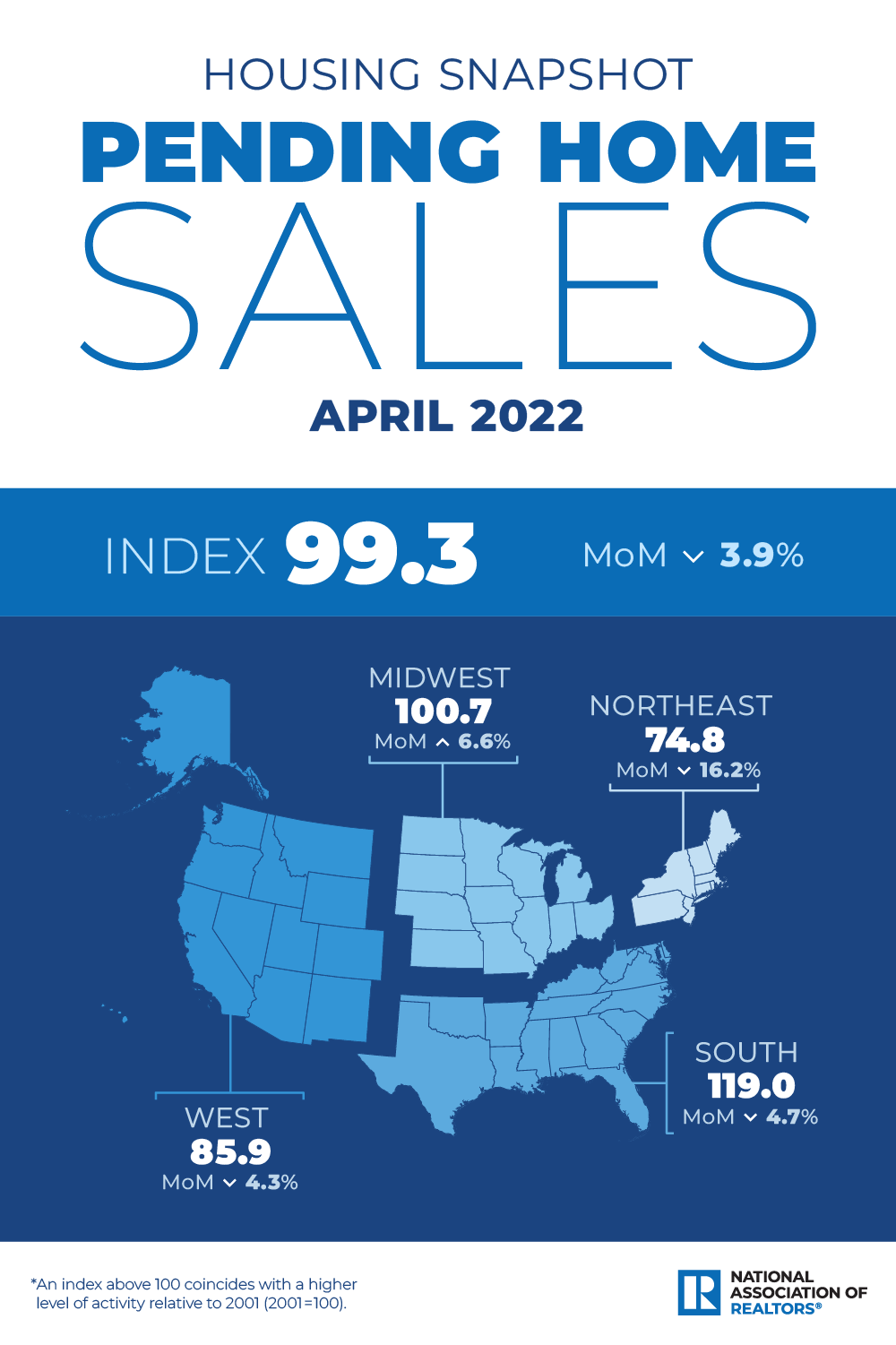The runup of mortgage rates continues to deal a blow to the housing market as April saw another decline in contract signings, according to recent data from the National Association of REALTORS® (NAR).
NAR’s Pending Home Sales Index (PHSI), a forward-looking indicator of home sales based on contract signings, fell by 3.9% last month—dipping to 99.3. That’s down 9.1% year-over-year.
While the Midwest experienced a monthly increase in pending sales, the remaining regions declined. Each region also experienced a decline in annual contract signings.
April markets the sixth consecutive month of declines in pending sales as experts suggest that buyers significantly feel the strain of climbing mortgage rates. NAR indicated that higher rates increase mortgage payments by as much as $500 per month in some cases.
With mortgage rates rising, NAR forecasts existing-home sales to wane by 9% in 2022 and home price appreciation to moderate to 5% by year’s end.
The burden has been compounded by elevated inflation, and home prices that have continued to rise, which experts suggest are pushing buyers to expand their search radius for more affordable homes or opt for different home financing options.

Regional breakdown:
Northeast
-16.2% MoM — Now 74.8 PHSI
-14.3% YoY
Midwest
+6.6% MoM — 100.7 PHSI
-2.8% YoY
South
-4.7% MoM — 119.0 PHSI
-10.3% YoY
West
-4.3% MoM — 85.9 PHSI
-10.5% YoY
The takeaway:
“Pending contracts are telling, as they better reflect the timelier impact from higher mortgage rates than do closings,” said Lawrence Yun, NAR’s chief economist. “The latest contract signings mark six consecutive months of declines and are at the slowest pace in nearly a decade.
“The escalating mortgage rates have bumped up the cost of purchasing a home by more than 25% from a year ago, while steeper home prices are adding another 15% to that figure.
“The vast majority of homeowners are enjoying huge wealth gains and are not under financial stress with their home as a result of having locked into historically low-interest rates or because they are not carrying a mortgage. However, in this present market, potential homebuyers are challenged and thus may attempt to mitigate the rising cost of ownership by opting for a five-year adjustable-rate mortgage or by widening their geographic search area to more affordable regions.
“Home sales in 2022 are expected to be down about 9%, and if mortgage rates climb to 6%, then the sales activity could fall by 15%. Home prices, in the meantime, appear in no danger of any meaningful decline.
“There is an ongoing housing shortage, and properly listed homes are still selling swiftly—generally seeing a contract signed within a month,” Yun concluded.
“Many would-be buyers found that the opportunity to afford the required mortgage payments on a home had slipped out of their grasp,” said George Ratiu, senior economist and manager of Economic Research at realtor.com®. “The monthly decline was propelled by drops in all regions except the Northeast. Pending home sales were 9.1% below year-ago levels. The decline points to a noticeably slower sales season ahead.
“The spring real estate season has become more turbulent this year, as a trifecta of higher inflation, surging interest rates and rising prices clipped the wings of a market riding high on the overheated currents from 2021. In addition, the number of homes coming to market is making a rebound, as homeowners are ready to move beyond the pandemic and also cash in on sky-high equity. These strong cross-currents are cooling demand in visible ways—sales of both new and existing homes have been tumbling for the past several months, a clear indication that markets are adjusting to a new normal.
“Looking at the next few months, I expect that the pace of transactions will reflect the high cost of financing a home. For households seeking a reprieve from the affordability crisis, a move to a lower-cost locale may offer a solution. However, not everyone is able to relocate, especially as some companies insist on bringing workers back into offices, despite higher commuting costs and lagging wage growth,” Ratiu concluded.
“As we look ahead to the summer months, we continue to expect year-over-year declines in total pending home sales after the extremely hot market we witnessed in the summer of 2021,” said Ruben Gonzalez, chief economist, Keller Williams. “We expect to see inventory finally start to accumulate slowly toward more normal levels and away from the unprecedented lows of the last couple of years.
“Recently, the average 30-year fixed-rate mortgage appears to be leveling off around 5.25%, a full 2.25% above where rates were last year. These higher rates will be weighing on demand going forward; however, the market seems well-positioned to absorb the impact so far.”
We will be keeping a close eye on how inventory is accumulating for the rest of the year as an indicator of how the market is evolving.
For more information, visit www.nar.realtor.












